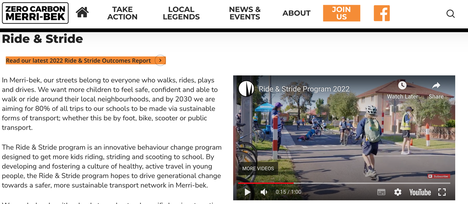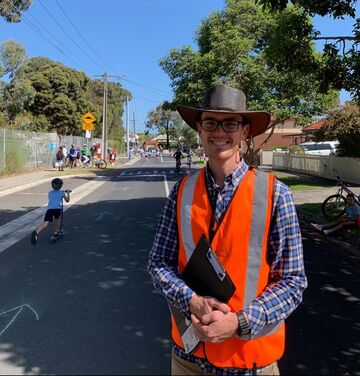|
By the time both of my children were at school I found myself wishing that our bike ride to and from school could be a little bit nicer. For context, it’s already nice-ish. Our school, Coburg North Primary School, has separated pedestrian and cycling paths that run right to the main entrance. It’s just that as usual, space is quite contested around school pick up and drop off times, and there is a lot of motor vehicle traffic. We also have to cross a very busy arterial road to get there. The inspiration to do something about it comes from my family’s lived experience of using active transport every day to school. Putting aside the daily constraints of the weather, it feels like our ambition to make active transport the first choice in our family is working well. But it isn’t exactly easy all the time. The chance came to do something about it when our council, Merri-bek (Victoria), started to directly engage with schools in a Ride and Stride program. As a volunteer on the school council, my first step was to work with the school in applying for this program. In our application we talked about how many children already ride to school, and we felt that this was only the beginning. The Ride and Stride program brought a range of new initiatives to our school. It enhanced our existing engagement in ride to school day, and also helped the council collect data on how many families used active transport to get to school, and how often. A centrepiece of the program was trialling “Open Streets”, where for a period of time before and after school the street is opened to humans by closing it to through motor vehicle traffic. As I’m sure many readers will appreciate, schools are busy places. We are fortunate in that our school supports these programs, but it is quite clear that they need to be community run to succeed here. Teachers have to teach. So the trick was to find a way to make this run with volunteers, so that we could deliver better active transport to the children, without putting any more burden on the school. The Open Streets trial events were carried off with great success, but quite a lot of work from the school, the council, and support from Bicycle Network. The trials revealed three things: that open streets can be carried out; that they have a huge impact on the amount of active transport used to get to school, and that an overwhelming majority in the community supported the idea. A successful trial needs to lead to something else, and in this case, it was establishing a fully fledged program. More than the trial, the program has to rely on volunteers. So in the background, I took on the role of lead volunteer in the program, which meant undertaking traffic management training, so that I could implement a traffic management plan. A traffic management plan is the sort of thing you see when roadworks are undertaken, we put signs out to advise of road closures in a safe way. These plans are drawn up by professionals. Another role of mine as lead volunteer was to build a team of willing adult volunteers who would help on the day. While I have to be present, as the person implementing the traffic management plan, each time we open the street, we also rely on other volunteers. We’ve got one person at each end of the street and another person roving the area. We provide advice on how to detour motor vehicles around the space, and we also help residents gain access to their homes if they need to, during the event. There’s even a building site in our area, and I often help the builders get their materials on site. An Open Streets event is a happy event. By opening a stretch of side street, only 100m long, we create an entirely different look and feel. The space becomes human centred. We close the road to motor vehicles from 8:15 to 9am. During this time, it’s wonderful to see how the space fills with families, and the children have lots more space to play, walk, ride and scoot – both to school and around the street once they arrive. The street becomes a social space, before the school bell rings. Lots of people hang around, the children play and chat to each other, and frankly the parents do the same. It changes the dynamic of the school drop off. In the afternoons from 3:15pm to 4:15 we do it again. When school ends at 3:30 pm, it fills up with people who sometimes hang around for a short time, and sometimes as long as they can! The afternoons have more of a relaxed feel, perhaps because of being on a Friday. Being a volunteer on the school council was no doubt a part of getting this initiative started. It also has to be said that the leadership from Merri-bek has been superb. Naturally, our school principal and leadership team have been instrumental as well. They understand the educational benefits of children using active transport to get to school, so the whole program is in their interest. So far this year, we’ve been running open streets on the first Friday of every month. We launched with a celebratory feel, and now have ingrained them as kind of normal. Every event isn’t a party, it just feels like a little slice of somewhere else, happening here in suburban Melbourne. In the beginning, I fielded plenty of questions from locals, but these have become much easier to answer as the evidence - that is, happy children playing - becomes visible. If you’ve ever had curiosity about what can be done at your school to improve active transport, then my suggestions are straightforward. First of all, contribute to your school council by volunteering. Secondly, make the time to explain the educational benefits of active transport to the school. Thirdly, engage with your local government on active transport. This last step for me was easy, but even if it’s difficult, I think it is always worth trying. For more info about the program and to read the reports visit: https://zerocarbonmerri-bek.org.au/travel-smart/ride-and-stride/ Robbie NapperRobbie Napper is a parent of two primary school aged children and lives with his family in Coburg, a Northern suburb of Melbourne. When not volunteering, Robbie is a Senior Lecturer at Monash University and sustainable transport expert. He is Deputy Director of Monash's Mobility Design Lab, member of the Australasian College of Road Safety, and holds a PhD in Industrial Design specialising in mobility. He is co-author of the book: Urban Mobility Design.
0 Comments
Leave a Reply. |
Archives
July 2024
Categories
All
|



 RSS Feed
RSS Feed